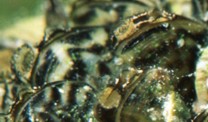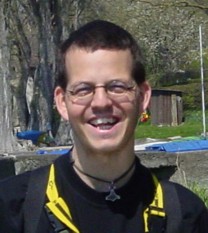For amphipods, there only few polymorphic microsatellite loci are kown. Therefore, I estabilshed new
polymorphic loci for the amphipod
Gammarus pulex by using EST-sequences from GenBank. The emerging loci were cross-tested for
other native and invasive species of the Peracarida, which derived few potential loci for other species. In the ongoing research, I want to
investigate the expansion of invasive ampipod species, and the consequences of their establishment in ecosystems on the native community, especially
in other amphipod species.
2. The Dreissena-biodeposition based food web
This may be a case of omnivory in a detritus based food web, with Gammarus and chironomids competing for a shared
resource and Gammarus preying on chironomids. Our research objective is to study the interactions involved in this
food web (e.g., seasonal patterns of biodeposition, food quality of deposited material for Gammarus, influence of
Gammarus on chironomid densities, influence of enrichment on the relative densities of both main taxa). During this
work, we will always keep in mind that the invasion by Dikerogammarus may severely disturb the Dreissena-biodeposition
based community.
3. Influence of the neozoe Limnomysis benedeni in Lake Constance
In summer 2006, the Ponto-Caspian mysid
L. benedeni invaded into Lake Constance and colonized the place of discovery
very fast. Although the mysid is common in the Rhine and Danube river system, only little is known about the ecology of
L. benedeni and the ecological consequences of the invasion into Lake Constance are still unknown.
We want to investigate and compare the life cycle and ecology of the mysid in Lake Constance with known data from rivers. In
doing so, it is essential to do a routine sampling program. By measuring population parameters and additionally laboratory experiments,
we are able to describe the life cycle of
L. benedeni. Laboratory experiments to further aspects of the syn- and autecology
are also planned for the future.
These are preparatory work to assess the influence of the new species to the benthic community in the littoral of Lake Constance.
© 20-11-2009. Universität Konstanz , 78457 Konstanz / Webmaster



